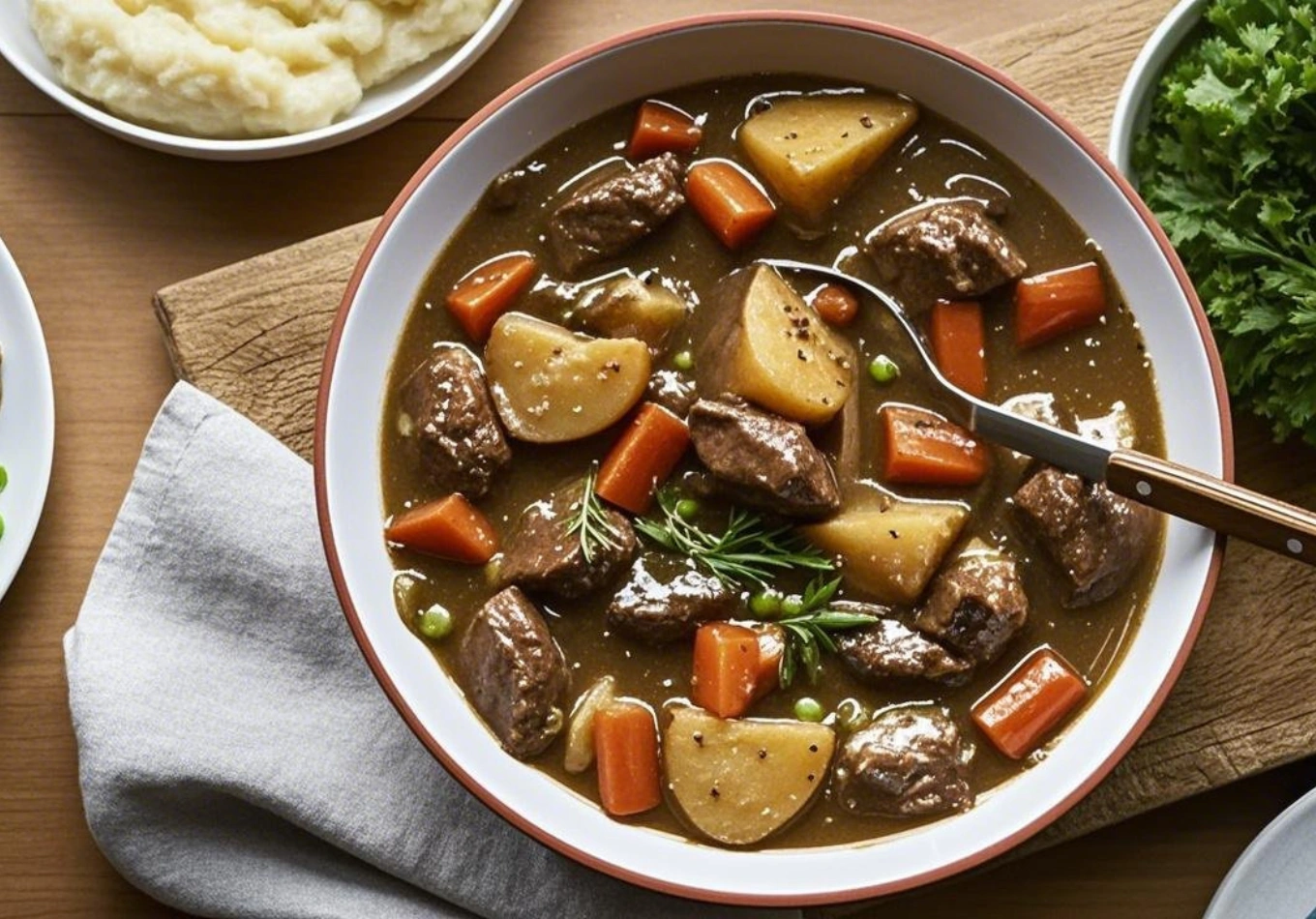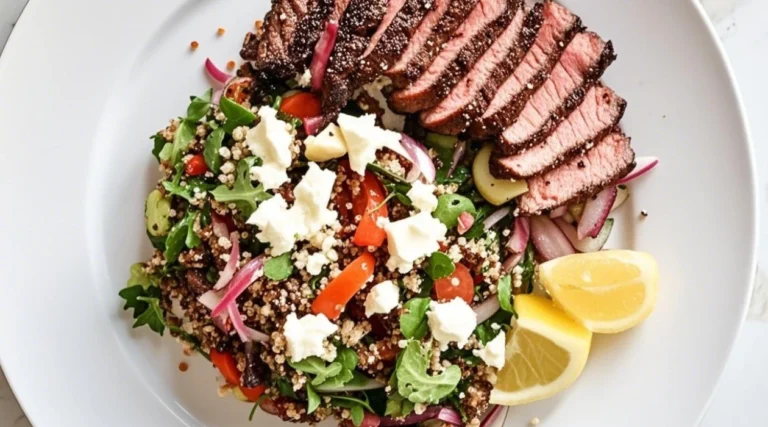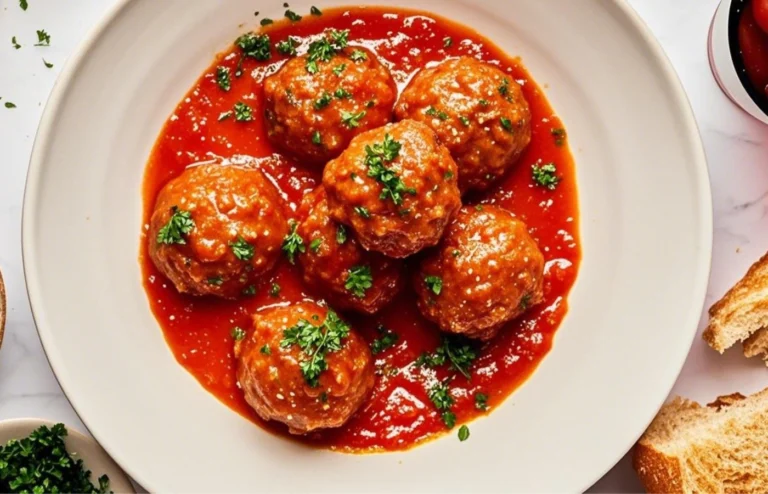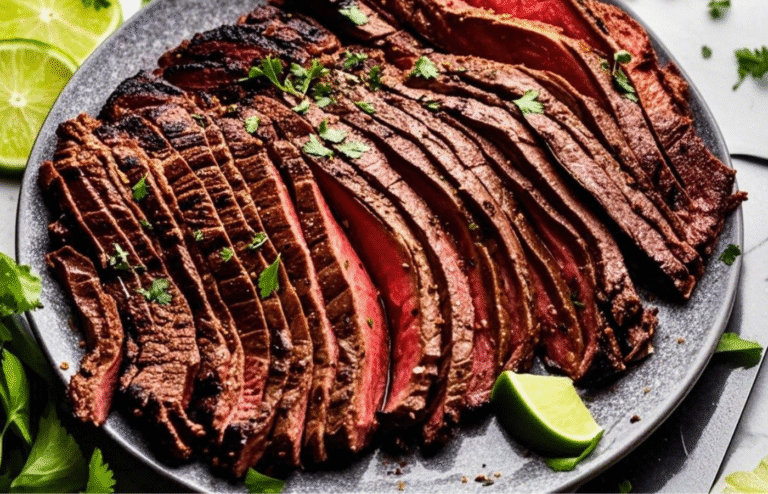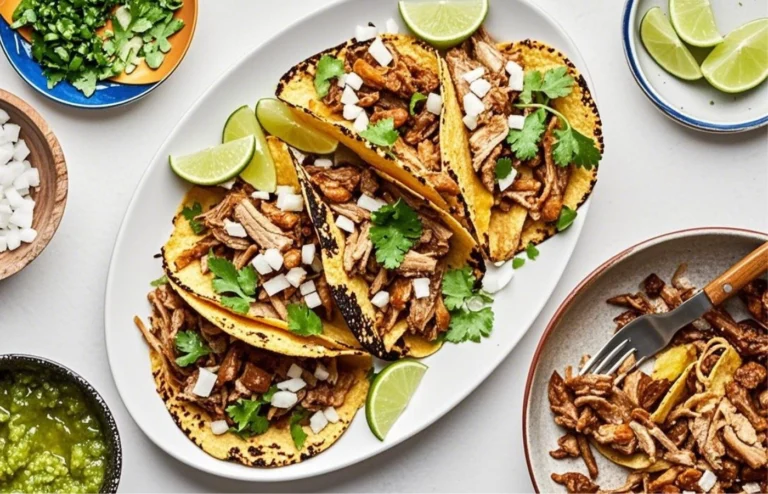The Ultimate Beef Stew: Rich, Hearty & Packed with Soul-Warming Flavor
Table of Contents
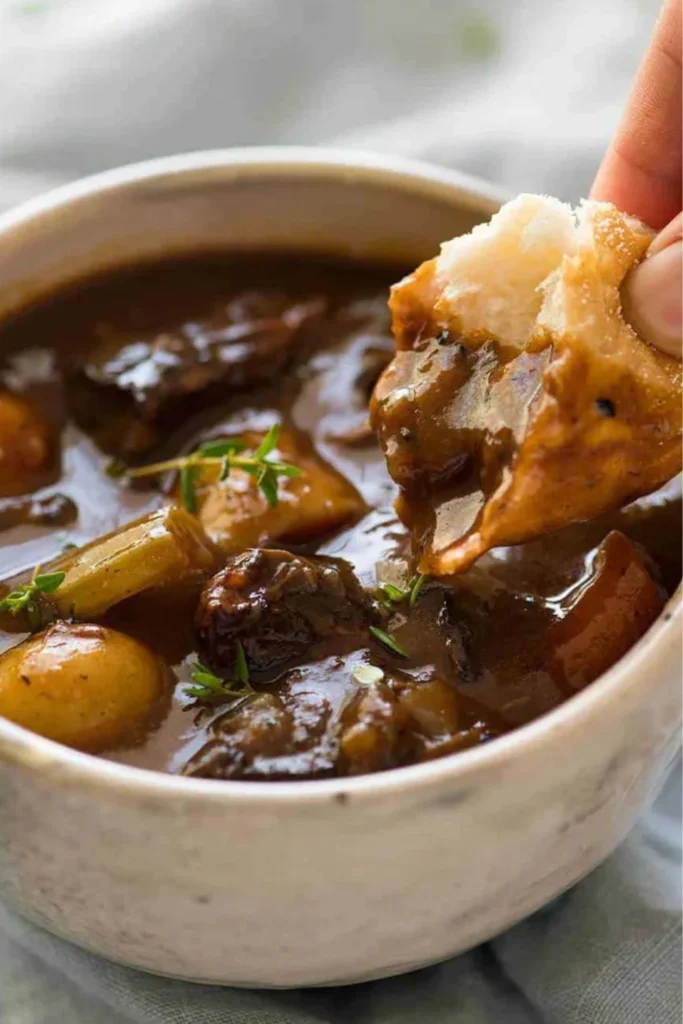
The gentle bubbling of a pot on the stove. Steam rising, carrying with it an aroma that instantly transports you back to childhood winters. There’s something nearly magical about the way beef stew transforms your kitchen into a sanctuary of comfort during those bone-chilling months.
I still remember my grandmother’s kitchen on those snowy Vermont afternoons—windows fogged from the heat within, the rich scent of beef and herbs mingling in the air as her wooden spoon scraped against the bottom of her ancient cast iron Dutch oven. “Patience,” she’d say, “is what transforms tough meat into something that melts in your mouth.”
That patience—and a handful of chef-inspired techniques I’ve gathered over decades in the kitchen—is what elevates an ordinary beef stew to an extraordinary one. By the time you finish reading, you’ll have every secret, technique, and ingredient needed to create the most flavorful beef stew that will undoubtedly become your family’s new favorite comfort food.
What Makes a Truly Great Beef Stew?
Not all beef stews are created equal. The difference between a mediocre bowlful and one that inspires silence at the dinner table (interrupted only by appreciative murmurs) comes down to understanding the alchemy that happens in your pot.
The transformation begins with proper browning—not just cooking, but developing that deep mahogany crust on chunks of beef that creates the foundation of flavor. Each subsequent layer builds upon this foundation: the caramelization of vegetables, the deglazing that captures every morsel of flavor from the bottom of the pot, and the patient, slow-cooking process that allows collagen to break down and flavors to meld.
Regional traditions certainly influence what constitutes the “best” beef stew. French kitchens might lean heavily on red wine and herbs for their Beef Bourguignon. Irish traditions might emphasize Guinness and root vegetables. American frontier versions might feature tomatoes and potatoes. Each tradition brings its own merits, but the recipe we’re exploring today takes the best elements from these traditions and combines them into something truly exceptional.
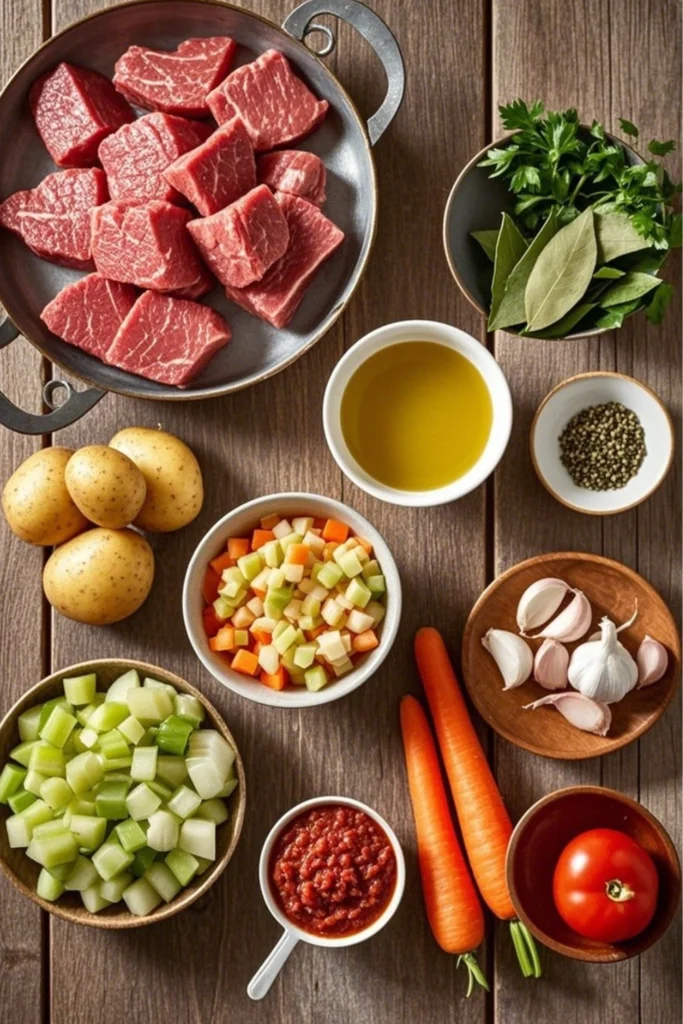
Essential Ingredients for the Best Beef Stew
Selecting the Perfect Cut of Beef
Your journey toward an unforgettable beef stew begins at the butcher counter. While you might be tempted by prettier, leaner cuts, beef chuck roast reigns supreme in the stew world. Why? This humble shoulder cut contains the perfect balance of meat, fat, and connective tissue.
These connective tissues—primarily collagen—transform during slow cooking. What begins as tough sinew slowly dissolves, creating that signature mouth-coating richness that defines an exceptional stew. As collagen breaks down, it converts to gelatin, lending body to your broth while simultaneously tenderizing the meat.
If chuck isn’t available, consider short ribs for their exceptional marbling, or brisket point for its robust flavor. Whichever cut you choose, aim for pieces with noticeable marbling rather than stark, lean meat. When cutting your beef, create generous 1½-inch chunks rather than small bits—larger chunks maintain juiciness and develop better texture during the long cooking process.
The Foundation Vegetables
The classic mirepoix—that humble trio of onions, carrots, and celery—forms the aromatic foundation upon which great stews are built. But their contribution goes beyond mere flavor. As these vegetables cook, they release natural sugars that add complexity to your stew’s profile.
Yellow onions work wonderfully for their balanced sweetness when caramelized, though shallots make an excellent substitution for a slightly more refined flavor profile. Carrots contribute both sweetness and earthy depth, while celery adds a green, almost herbal quality that rounds out the base.
Beyond this foundation, mushrooms deserve special mention. Their natural glutamates amplify the meaty flavor of your stew through a process food scientists call “umami synergy”—essentially, the mushrooms make the beef taste beefier. Cremini (baby portobello) mushrooms work spectacularly here for their firm texture and concentrated flavor.
Yukon gold potatoes hold their shape beautifully while absorbing surrounding flavors. Their waxy nature prevents them from disintegrating during long cooking times, unlike starchier varieties that might turn your stew muddy.

Building Rich Flavor with Liquids and Aromatics
The liquid component of your stew deserves thoughtful consideration. While water technically works, it adds nothing to the flavor equation. A good-quality beef broth forms a superior base, though some chefs swear by using half beef broth and half chicken stock for a more balanced profile with less intensity.
Wine brings acidity and complexity that cuts through the richness. A medium-bodied red like Pinot Noir offers depth without overwhelming tannins. For deglazing your pan after browning meat, wine’s acidity works wonders at lifting those caramelized bits from the cooking surface—bits that contain concentrated flavor compounds created during the Maillard reaction.
Aromatics and seasonings transform a good stew into an exceptional one. Fresh herbs offer brightness that dried varieties can’t match. Thyme’s earthy, floral notes complement beef beautifully, while rosemary contributes piney intensity. Bay leaves impart subtle complexity over long cooking periods.
For depth beyond herbs, consider these “secret” ingredients:
- Worcestershire sauce contributes umami through its fermented anchovy base
- A touch of balsamic vinegar adds both sweetness and acidity
- A spoonful of Dijon mustard provides subtle heat and complexity
- A square of dark chocolate (yes, chocolate!) adds remarkable depth in nearly imperceptible amounts
Complete Ingredient List for the Best Beef Stew
| Category | Ingredients | Quantity |
|---|---|---|
| Protein | Chuck roast, cut into 1.5-inch cubes | 2.5 pounds |
| Vegetables | Yellow onions, diced | 2 medium |
| Carrots, cut into chunks | 4 large | |
| Celery stalks, diced | 3 stalks | |
| Yukon gold potatoes, quartered | 1.5 pounds | |
| Cremini mushrooms, quartered | 8 ounces | |
| Garlic cloves, minced | 4 cloves | |
| Liquids | Beef broth | 4 cups |
| Dry red wine | 1 cup | |
| Tomato paste | 2 tablespoons | |
| Herbs & Seasonings | Bay leaves | 2 leaves |
| Fresh thyme | 4 sprigs | |
| Fresh rosemary | 2 sprigs | |
| Worcestershire sauce | 1 tablespoon | |
| Others | All-purpose flour | 1/4 cup |
| Olive oil | 3 tablespoons | |
| Salt and pepper | To taste |
Step-by-Step Method for Perfect Beef Stew
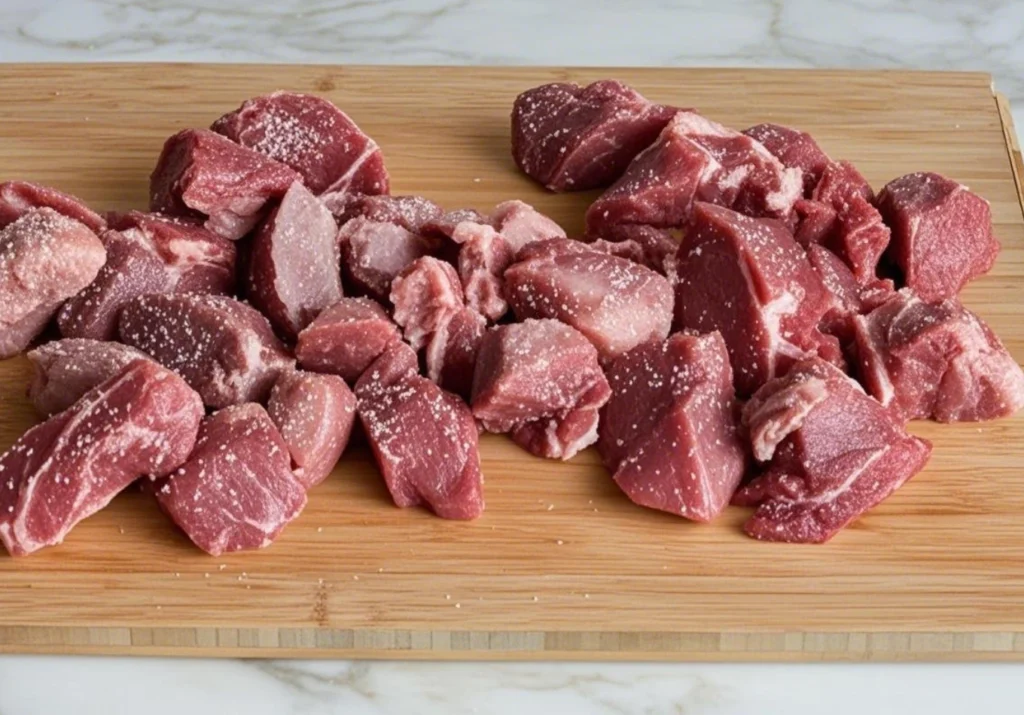
Preparing the Beef for Maximum Flavor
Transformative beef stew begins well before heat meets meat. Start by thoroughly patting your beef chunks dry with paper towels—moisture is the enemy of proper browning. Season generously with salt and freshly ground black pepper, allowing the meat to sit for 15-20 minutes at room temperature to take the chill off.
When browning, patience becomes your greatest virtue. Work in small batches—overcrowding your pan causes meat to steam rather than sear. Each piece should have ample space around it, allowing moisture to escape and caramelization to occur. A heavy-bottomed Dutch oven distributes heat evenly, creating that coveted crust.
Common mistakes during this crucial phase include:
- Stirring too frequently (resist the urge—let that crust develop)
- Starting with oil that isn’t hot enough (it should shimmer before adding meat)
- Rushing the process (proper browning of all your meat might take 15-20 minutes)
Remember, you’re not cooking the meat through at this stage—you’re developing flavor. The interior will remain raw, cooking to perfect tenderness during the slow-cooking phase.
Building the Flavor Base
Once your meat has developed that magnificent crust and rests on a plate nearby, lower the heat and add your mirepoix to the same pot. The vegetables will release moisture, helping to loosen those concentrated flavor bits (fond) from the bottom of the pot—a process called deglazing.
Allow your vegetables to soften and develop golden edges, indicating their natural sugars have begun caramelizing. This typically takes 7-10 minutes of occasional stirring. Add garlic only in the final minute to prevent bitterness from overcooking.
Next comes the tomato paste—cook it for 1-2 minutes until it darkens slightly, which removes raw tomato flavor and creates deeper, more complex notes. Sprinkle flour over your vegetable mixture and cook for another minute, creating a light roux that will thicken your stew.
Now comes the true deglazing moment—add your wine and use a wooden spoon to scrape vigorously at the bottom of the pot, releasing any remaining fond. Let the wine reduce by half, concentrating its flavor before adding your broth, browned meat, and bundle of fresh herbs.
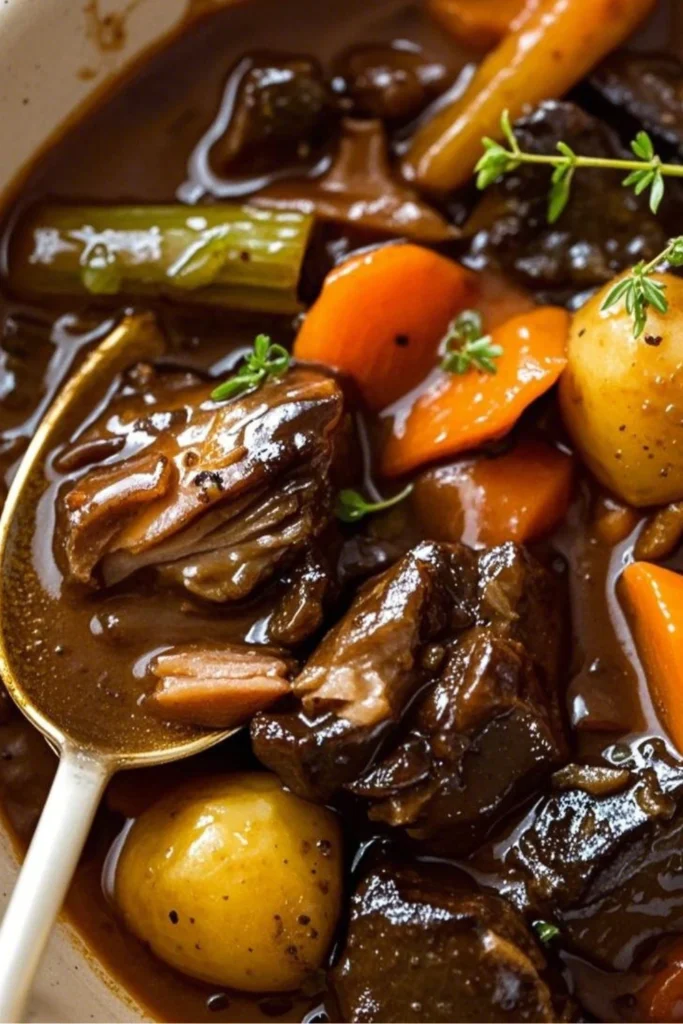
Slow Cooking Methods for Tender, Flavorful Results
The cooking vessel and method you choose significantly impact your final results:
A Dutch oven provides superior heat retention and distribution. When placed in a 325°F oven, it creates a gentle, consistent environment where meat can tenderize without aggressive bubbling that might toughen protein fibers.
Stovetop cooking works well but requires more attention to maintain a proper simmer. The benefit? You can more easily check tenderness and adjust seasonings throughout cooking.
Slow cookers offer convenience but sacrifice some flavor development—browning must happen separately, and their lower temperatures can extend cooking times significantly.
Regardless of method, your stew requires time—typically 2.5 to 3 hours—to transform tough collagen into silky gelatin. You’ll know your stew has reached perfection when the meat offers little resistance when pierced with a fork.
Add potatoes during the final hour of cooking to prevent them from becoming overly soft. Similarly, if using mushrooms, adding them later preserves their texture while still allowing them to contribute flavor.
Once your stew finishes cooking, allow it to rest for 15-20 minutes before serving. This rest period allows flavors to settle and meld while the temperature drops to a more palatable level.
Tips and Tricks from Professional Chefs
Professional kitchens employ several techniques that home cooks can easily adopt:
- Consider browning just half your meat, leaving the remainder with its natural enzymes intact, which some chefs believe creates a more complex flavor profile.
- For exceptional depth, roast your vegetables separately until caramelized before adding them to your stew.
- Master the art of seasoning in stages rather than all at once—add salt at the beginning when browning meat, halfway through cooking, and again at the end for balanced flavor throughout.
- When facing a thin stew, reduce liquid by removing the lid during the final 30 minutes of cooking. For quicker thickening, create a slurry of equal parts cornstarch and cold water, stirring it into your simmering stew.
- Perhaps counterintuitively, making your stew a day ahead dramatically improves its flavor profile. Overnight refrigeration allows flavors to mature as proteins continue absorbing surrounding seasonings.
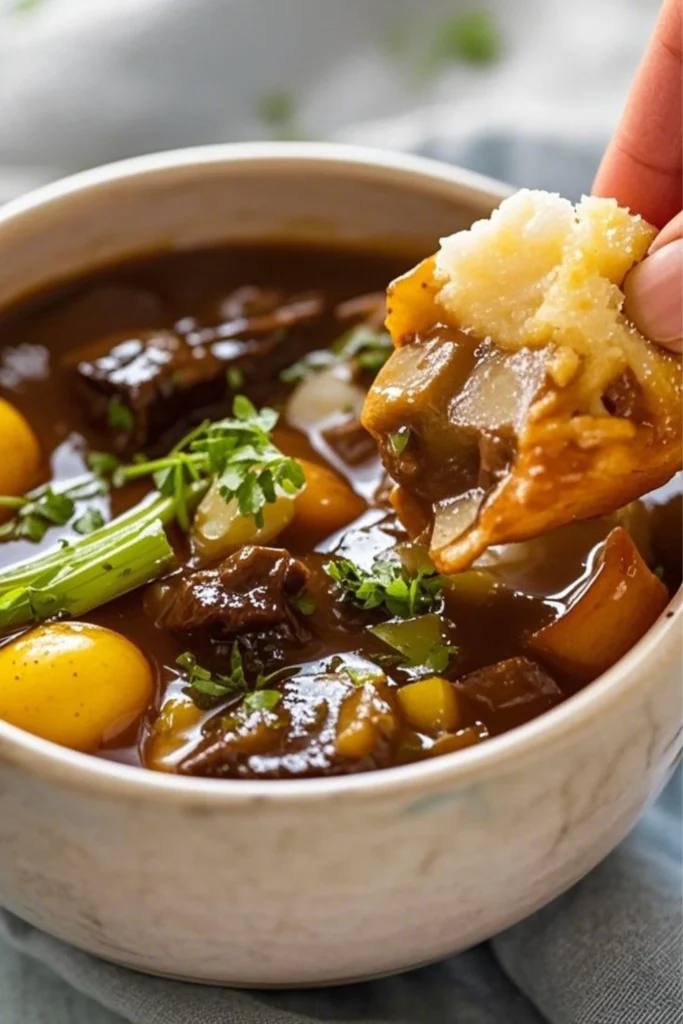
Serving and Pairing Your Best Beef Stew
Perfect Accompaniments
While beef stew stands proudly on its own, thoughtful accompaniments enhance the experience. Crusty, rustic bread serves as both utensil and sponge for capturing every drop of that precious gravy. Sourdough offers pleasant tanginess against the stew’s richness, while a hearty country loaf provides satisfying chew.
For those seeking additional sides, consider:
- Buttered egg noodles with chopped parsley
- A bright, acidic salad with vinaigrette to cut through richness
- Roasted garlic mashed potatoes for ultimate comfort
Wine pairings depend somewhat on your stew’s flavor profile. Generally, medium-bodied reds with moderate tannins complement without overwhelming. Consider Côtes du Rhône, Chianti, or Merlot—wines with enough structure to stand up to beef but sufficient fruit to harmonize with vegetables.
Storage and Reheating for Even Better Flavor
The magic of beef stew extends beyond its first serving. Chemistry continues working as your stew rests in the refrigerator, with flavors melding and deepening over 24-48 hours.
Store your stew in airtight containers, allowing it to cool completely before refrigeration. When reheating, do so gently over medium-low heat, adding small amounts of broth if needed to restore consistency.
For freezing, leave slight headspace in containers to accommodate expansion. Properly stored stew maintains quality for up to three months. Thaw overnight in your refrigerator before reheating for best results.
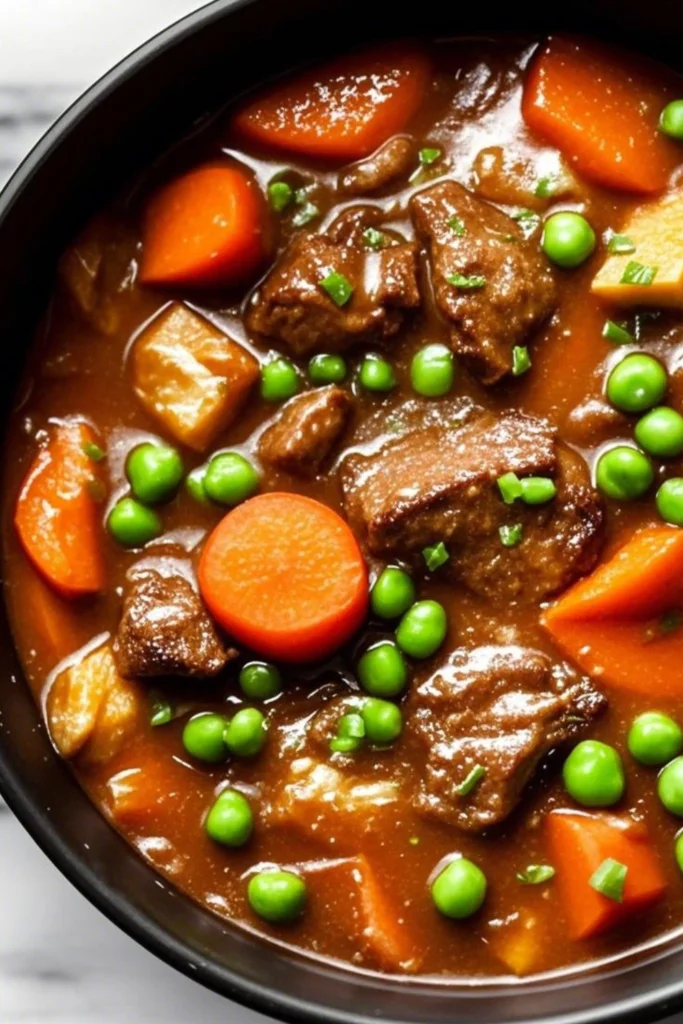
Variations on the Classic Beef Stew
While this recipe stands magnificently on its own, consider these variations to keep your stew repertoire fresh:
French Beef Bourguignon emphasizes wine (traditionally Burgundy) with pearl onions and lardons. The finished stew offers sophisticated depth with subtle variations in texture.
Hungarian Goulash introduces paprika as its defining characteristic, creating a brick-red broth with distinctive warmth and subtle heat.
Irish Beef Stew traditionally features Guinness stout instead of wine, creating maltier undertones complemented by root vegetables.
For those requiring dietary modifications:
- Replace all-purpose flour with cornstarch for gluten-free thickening
- Reduce sodium by using unsalted broth and adjusting seasoning to taste
- Incorporate more vegetables and less meat for a lighter approach
Pressure cooker adaptations dramatically reduce cooking time to approximately 35 minutes at high pressure, though you’ll sacrifice some of the flavor development that comes with longer cooking methods.
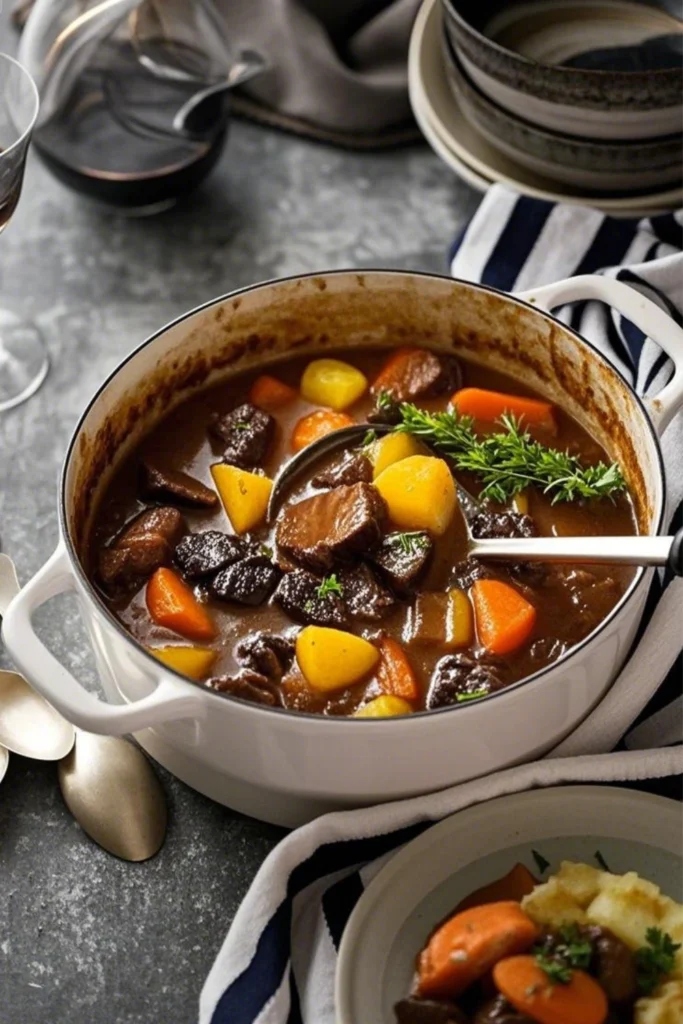
Frequently Asked Questions About Beef Stew
Why is my beef stew meat tough even after long cooking?
Tough meat typically results from insufficient cooking time or improper temperature. Collagen requires sustained heat (around 200°F) to break down properly. If your stew hasn’t reached this temperature—or hasn’t maintained it long enough—the meat remains chewy rather than tender.
Another potential culprit? Using overly lean cuts that lack sufficient connective tissue. Without enough collagen to convert to gelatin, some cuts simply become dry rather than tender, regardless of cooking time.
Can I make the best beef stew in advance for a dinner party?
Absolutely—and you should! Beef stew positively thrives with advance preparation. Make your stew 1-2 days before your gathering, allowing it to cool completely before refrigerating in its cooking vessel or an airtight container.
When ready to serve, reheat gently over medium-low heat until the stew reaches serving temperature. The flavors will have harmonized beautifully during refrigeration, and you’ll have more time to focus on your guests rather than last-minute preparation.
What’s the secret to rich, dark beef stew gravy?
That enviable mahogany color and richness comes from multiple sources:
- Thorough browning of meat (don’t rush this step!)
- Caramelization of vegetables
- Cooking tomato paste until it darkens slightly
- Using red wine rather than white or additional broth
- Allowing your stew to reduce slightly with the lid partially off during final cooking
For additional color depth, some chefs add a teaspoon of kitchen bouquet or a small amount of concentrated beef base.
Can I freeze beef stew, and if so, what’s the best method?
Beef stew freezes exceptionally well, though potatoes may change texture slightly upon thawing. For optimal results:
- Cool your stew completely before freezing
- Store in airtight containers with 1/2-inch headspace for expansion
- Label with date and contents (future-you will appreciate this!)
- Use within 3 months for best quality
When ready to enjoy, thaw in your refrigerator overnight rather than using quick-thaw methods, which can affect texture and flavor.
What’s the difference between regular beef stew and the best beef stew recipe?
The distinction lies in technique and attention to detail. Superior beef stews result from:
- Selecting the right cut with adequate fat and connective tissue
- Taking time for proper browning rather than rushing
- Building flavors in layers (meat, vegetables, aromatics)
- Using quality ingredients, particularly fresh herbs and good wine
- Allowing sufficient cooking time for collagen transformation
- Seasoning thoughtfully throughout the cooking process
- Resting before serving to allow flavors to marry
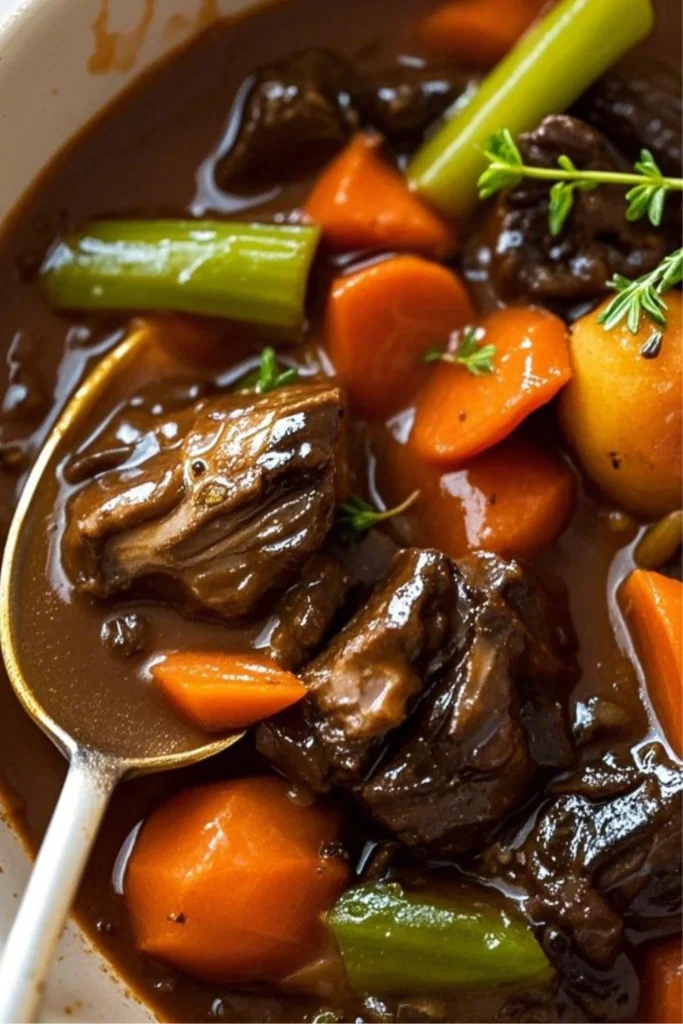
Mastering the Art of the Best Beef Stew
Creating truly remarkable beef stew isn’t about following rules rigidly—it’s about understanding principles. The techniques outlined here provide a foundation, but true mastery comes through making this recipe your own.
Perhaps you’ll incorporate an herb your grandmother always used, or a seasoning that speaks to your family’s heritage. Maybe you’ll discover that adding root vegetables from your garden creates a stew that tastes distinctly of your home and land.
We encourage you to share your variations and experiences. What unexpected ingredient elevated your stew? Which technique made the most noticeable difference? Through this community of sharing, we all become better cooks.
As temperatures drop and evenings grow longer, there’s profound satisfaction in mastering a dish that provides not just nourishment but comfort. A truly great beef stew connects us—to traditions, to seasons, to one another across the dinner table. There’s a reason this humble dish has endured through centuries and across cultures. In its depths lies something more satisfying than mere food—a sense of home, of care, of time invested in creating something truly special for those we love.
Why not start your pot simmering this weekend? Your kitchen—and your loved ones—will thank you.

